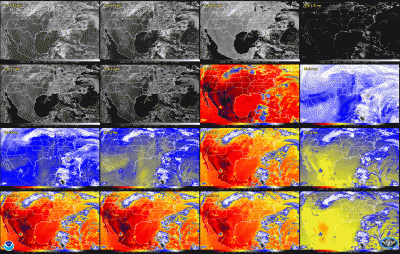The GOES-R Series Program has made sample datasets available that represent initial products generated from the GOES-R series ground segment during integration and test of product algorithms. These datasets are intended to give GOES-R users a first look at sample data. This data is provided for reference only and should not be considered final. As the ground system is built, more sample products and updates to the data will be posted as they become available. All datasets are available in NetCDF format.

Example of ABI L1b data for each of the 16 bands as simulated from high resolution numerical weather prediction model output and state-of-the-art radiative transfer models.
Additional test data is available through the University of Wisconsin, Madison, Space Science Engineering Center’s Community Satellite Processing Package (CSPP) for Geostationary Data. In March 2015, SSEC announced the release of the CSPP Geo GRB Prototype software package. This is the initial release of software that will allow direct broadcast users to process GOES Rebroadcast (GRB) data received on their antennas from the GOES-R satellite, after it is launched in 2016. The software is publicly available and free to use. The main functionality included in this release is to ingest a simulated GRB data stream, recover Advanced Baseline Imager (ABI) Level 1 and Geostationary Lightning Mapper (GLM) Level 2 data payloads, reconstruct the datasets, and write output to mission-standard NetCDF files.
The minimum system requirements for the CSPP Geo GRB software are:
• 12 core, 2.4 GHz CPU with 64-bit instruction support,
• 32GB RAM,
• CentOS 6 64-bit Linux (or other compatible 64-bit Linux distribution),
• 100 GB disk space
Root access may be needed on the target machine to configure network buffer settings to the recommended sizes.
A simulated ABI / GLM test case is provided, along with a test script that simulates the GRB data stream by sending UDP packets on a socket. In our internal testing, the software was able to keep up with the expected GRB data rate without packet loss when running on the recommended hardware.

